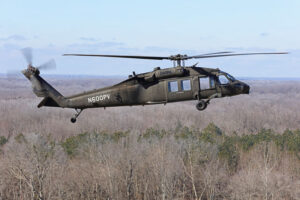DARPA and Lockheed Martin’s [LMT] Sikorsky announced Tuesday they have completed the first ever completely unmanned, autonomous flight with a UH-60 Black Hawk helicopter.
The UH-60A flew with no safety pilots onboard during a pair of recent demonstrations as part of DARPA’s Aircrew Labor In-Cockpit Automation System (ALIAS) program, which the Army has expressed interest in potentially leveraging the technology for its enduring fleet.

“Sikorsky’s advancements in flight automation and autonomy will be game-changers for Army aviators and ground commanders, particularly as the Army looks to modernize its enduring helicopter fleet with Future Vertical Lift,” Jay Macklin, Sikorsky’s business development lead for Army, Future Vertical Lift (FVL) and innovations programs, said in a statement. “This transformational technology will provide commanders and aircrews with a strategic advantage in countering complex new threat environments.”
Under the ALIAS program, which DARPA has been running for the past six years, Sikorsky has retrofitted a Black Hawk with its Matrix autonomy technology designed to help reduce pilot workload.
“With reduced workloads pilots can focus on mission management instead of the mechanics,” Stuart Young, program manager in DARPA’s Tactical Technology Office, said in a statement. “This unique combination of autonomy software and hardware will make flying both smarter and safer.”
During the two demonstrations on Feb. 5 and 7 at Ft. Campbell in Kentucky, the Black Hawk operated for 30 minutes with no pilots onboard, to include taking off and landing autonomously and conducting a simulated obstacle avoidance scenario.
“This capability will allow pilots to confidently switch back and forth between autonomy and piloted modes at any point of their mission with the literal flip of a switch. This will support autonomous flight during a wide range of missions such as flight in degraded visual environments and confined areas. Most critically, ALIAS will be capable of automatically detecting and preventing dangerous situations that lead to accidents, thereby saving lives,” Benjamin Wilson, lead test pilot for the Fort Campbell demonstrations, said in a statement.
With the ALIAS program potentially set to end this September, Young has previously said he anticipates the technology transitioning to the Army in the near future as the service anticipates potential use cases from aircrew augmentation to potential completely autonomous operations (Defense Daily, Nov. 12).
“It makes common fiscal sense that we’re going to have these very expensive Future Vertical Lift assets and there’s going to be missions where you’ll say I don’t need to send in a [very expensive] aircraft when I can send in an automated legacy or enduring aircraft. How the Army decides to use those is something the Army needs to figure out, but at least we have the technology to be able to do it,” Young told reporters during the Army’s recent Project Convergence experiment at Yuma Proving Ground in Arizona.
Maj. Gen. Walter Rugen, director of the of the Army’s FVL Cross-Functional Team, has also said he sees opportunities for an autonomous Black Hawk to potentially act as a souped-up version of a UAS capable of extensive distances and cargo-carrying ability for logistics operations.
“On the logistics front, when you look at what ALIAS is doing with the absolutely cargo carrying capacity of the Black Hawk and the range, I haven’t seen a UAS meet that yet. And the fact that ALIAS is doing that and showing that we can carry 6,000 to 8,000 pounds of cargo at our UH-60 ranges, somebody’s going to have to come up with a pretty compelling UAS that’s vertical lift, that can carry that amount and do it at that range,” Rugen also told reporters during Project Convergence.